A Simple Method Using High Matric Suction Calibration Points to Optimize Soil–Water Characteristic Curves Derived from the Centrifuge Method
Abstract
1. Introduction
2. Materials and Methods
2.1. Soil Sampling
2.2. Determination of the Soil Physical Properties, Water Constants, and Saturated Hydraulic Conductivity
2.3. Establishment of the SWCC
2.3.1. Operation Process of the Centrifuge Method
2.3.2. Calculation of the Soil Matric Suction and Volumetric Water Content
2.3.3. Fitting Model of the SWCC
2.4. Correcting of the SWCC
2.5. Simulations of Farmland Soil Moisture Dynamics via the Hydrus-1D Model
2.5.1. Setting of the Initial and Boundary Conditions for the Hydrus-1D Model
2.5.2. Setting of the Hydrus-1D Model Parameters
2.6. Data Analysis and Model Evaluation
3. Results
3.1. Soil Shrinkage and BD Changes During Centrifugation
3.2. Comparison of SWCCs Derived from Different Methods
3.3. Evaluation of SWCCs Based on Simulations of Soil Water Constants and Farmland Soil Moisture Dynamics
4. Discussion
4.1. Soil Shrinkage and BD Changes During Centrifugation Cannot Be Neglected
4.2. Impacts of Soil Shrinkage and BD Changes on the SWCC
4.3. Optimizing SWCCs Derived from the Centrifuge Method via High Matric Suction Calibration Points
5. Conclusions
Supplementary Materials
Author Contributions
Funding
Institutional Review Board Statement
Data Availability Statement
Acknowledgments
Conflicts of Interest
References
- Sprenger, M.; Tetzlaff, D.; Buttle, J.; Carey, S.K.; Mcnamara, J.P.; Laudon, H.; Shatilla, N.J.; Soulsby, C. Storage, mixing, and fluxes of water in the critical zone across northern environments inferred by stable isotopes of soil water. Hydrol. Process 2018, 32, 1720–1737. [Google Scholar] [CrossRef]
- Xing, X.; Kang, D.G.; Ma, X. Differences in loam water retention and shrinkage behavior: Effects of various types and concentrations of salt ions. Soil Tillage Res. 2017, 167, 61–72. [Google Scholar] [CrossRef]
- Rattan, B.; Dwivedi, M.; Garg, A.; Sekharan, S.; Sahoo, L. Combined influence of water-absorbing polymer and vegetation on soil water characteristic curve under field condition. Plant Soil 2024, 499, 491–502. [Google Scholar] [CrossRef]
- Li, L.; Li, X.; Wang, L.; Hong, B.; Shi, J.; Sun, J. The effects of soil shrinkage during centrifuge tests on SWCC and soil microstructure measurements. B Eng. Geol. Environ. 2020, 79, 3879–3895. [Google Scholar] [CrossRef]
- Wu, H.; Lei, X.W.; Chen, X.; Shen, J.H.; Wang, X.Z.; Ma, T.T. Study on Effect of Particle Size Distribution on Water-Retention Capacity of Coral Sand from Macro and Micro Perspective. J. Mar. Sci. Eng. 2024, 12, 341. [Google Scholar] [CrossRef]
- Xing, X.; Li, Y.; Ma, X. Water retention curve correction using changes in bulk density during data collection. Eng. Geol. 2018, 233, 231–237. [Google Scholar] [CrossRef]
- Zhou, H.; Zhao, W.Z. Modeling soil water balance and irrigation strategies in a flood-irrigated wheat-maize rotation system. A case in dry climate, China. Agr. Water Manag. 2019, 221, 286–302. [Google Scholar] [CrossRef]
- Rahimi, A.; Rahardjo, H.; Leong, E.C. Effect of range of soil-water characteristic curve measurements on estimation of permeability function. Eng. Geol. 2015, 185, 96–104. [Google Scholar] [CrossRef]
- Ma, J.; Zeng, R.; Bian, S.; Meng, X.; Zhang, Z.; Khalid, Z. Prediction of hysteretic soil and water characteristic curve of loess based on multifractal theory and improved physical statistics. J. Hydrol. 2024, 632, 130898. [Google Scholar] [CrossRef]
- Fu, X.; Shao, M.; Lu, D.; Wang, H. Soil water characteristic curve measurement without bulk density changes and its implications in the estimation of soil hydraulic properties. Geoderma 2011, 167–168, 1–8. [Google Scholar] [CrossRef]
- Rao, J.; Yi, L.; Wan, Y.; Wen, T.; Chen, Z. Dual effects of supergravity deformation and suction deformation on the determination of soil water characteristic curve by centrifugal testing method. Soil Tillage Res. 2025, 249, 106495. [Google Scholar] [CrossRef]
- Liu, H.; Rahardjo, H.; Satyanaga, A.; Du, H. Use of osmotic tensiometers in the determination of soil-water characteristic curves. Eng. Geol. 2023, 312, 106938. [Google Scholar] [CrossRef]
- Hamdany, A.H.; Shen, Y.; Satyanaga, A.; Rahardjo, H.; Lee, T.D.; Nong, X. Field instrumentation for real-time measurement of soil-water characteristic curve. Int. Soil Water Conserv. Res. 2022, 10, 586–596. [Google Scholar] [CrossRef]
- Reatto, A.; Da Silva, E.M.; Bruand, A.; Martins, E.S.; Lima, J.E.F.W. Validity of the Centrifuge Method for Determining the Water Retention Properties of Tropical Soils. Soil Sci. Soc. Am. J. 2008, 72, 1547–1553. [Google Scholar] [CrossRef]
- Wang, Y.; Zhang, A.; Ren, W.; Niu, L. Study on the soil water characteristic curve and its fitting model of Ili loess with high level of soluble salts. J. Hydrol. 2019, 578, 124067. [Google Scholar] [CrossRef]
- Shang, L.; Li, D. Comparison of different approaches for estimating soil water characteristic curves from saturation to oven dryness. J. Hydrol. 2019, 577, 123971. [Google Scholar] [CrossRef]
- Jia, A.; Song, X.; Li, S.; Liu, Z.; Liu, X.; Han, Z.; Gao, H.; Gao, Q.; Zha, Y.; Liu, Y.; et al. Biochar enhances soil hydrological function by improving the pore structure of saline soil. Agr. Water Manag. 2024, 306, 109170. [Google Scholar] [CrossRef]
- Chen, J.; Wu, Z.; Zhao, T.; Yang, H.; Long, Q.; He, Y. Rotation crop root performance and its effect on soil hydraulic properties in a clayey Utisol. Soil Tillage Res. 2021, 213, 105136. [Google Scholar] [CrossRef]
- Kong, D.; Wu, T.; Xu, H.; Jiang, P.; Zhou, A.; Lv, Y. Variation and correlation between water retention capacity and gas permeability of compacted loess overburden during wetting-drying cycles. Environ. Res. 2024, 252, 118895. [Google Scholar] [CrossRef] [PubMed]
- Li, L.; Li, X.; Lei, H.; Hong, B.; Wang, L.; Zheng, H. On the characterization of the shrinkage behavior and soil-water retention curves of four soils using centrifugation and their relation to the soil structure. Arab. J. Geosci. 2020, 13, 1259. [Google Scholar] [CrossRef]
- Lai, Y.; Garg, A.; Chang, K.; Xing, X.; Fan, J.; Liang, J.; Yu, M. A novel method to inverse the water retention curves with consideration of volume change during centrifuge testing. Soil Sci. Soc. Am. J. 2021, 85, 207–216. [Google Scholar] [CrossRef]
- Bittelli, M.; Flury, M. Errors in Water Retention Curves Determined with Pressure Plates. Soil Sci. Soc. Am. J. 2009, 73, 1453–1460. [Google Scholar] [CrossRef]
- Rahardjo, H.; Nong, X.F.; Lee, D.T.T.; Leong, E.C.; Fong, Y.K. Expedited Soil–Water Characteristic Curve Tests Using Combined Centrifuge and Chilled Mirror Techniques. Geotech. Test. J. 2017, 41, 207–217. [Google Scholar] [CrossRef]
- Wen, T.; Chen, X.; Shao, L. Effect of multiple wetting and drying cycles on the macropore structure of granite residual soil. J. Hydrol. 2022, 614, 128583. [Google Scholar] [CrossRef]
- Federico, A.M.; Miccoli, D.; Murianni, A.; Vitone, C. An indirect determination of the specific gravity of soil solids. Eng. Geol. 2018, 239, 22–26. [Google Scholar] [CrossRef]
- Robinson, D.A.; Thomas, A.; Reinsch, S.; Lebron, I.; Feeney, C.J.; Maskell, L.C.; Wood, C.M.; Seaton, F.M.; Emmett, B.A.; Cosby, B.J. Analytical modelling of soil porosity and bulk density across the soil organic matter and land-use continuum. Sci. Rep. UK 2022, 12, 7085. [Google Scholar] [CrossRef]
- Corral-Pazos-De-Provens, E.; Rapp-Arrarás, Í.; Domingo-Santos, J.M. Estimating textural fractions of the USDA using those of the International System: A quantile approach. Geoderma 2022, 416, 115783. [Google Scholar] [CrossRef]
- Shiri, J.; Keshavarzi, A.; Kisi, O.; Karimi, S. Using soil easily measured parameters for estimating soil water capacity: Soft computing approaches. Comput. Electron. Agr. 2017, 141, 327–339. [Google Scholar] [CrossRef]
- Shirazi, M.A.; Boersma, L. A Unifying Quantitative Analysis of Soil Texture. Soil Sci. Soc. Am. J. 1984, 48, 142–147. [Google Scholar] [CrossRef]
- Tan, S.; Su, X.; Jiang, X.; Yao, W.; Chen, S.; Yang, Q.; Ning, S. Irrigation Salinity Affects Water Infiltration and Hydraulic Parameters of Red Soil. Agronomy 2023, 13, 2627. [Google Scholar] [CrossRef]
- Gardner, W.R. A method of measuring the capillary tension of soil moisture over a wide moisture range. Soil Sci. 1937, 4, 277–284. [Google Scholar] [CrossRef]
- Brooks, R.H.; Corey, A.T. Hydraulic Properties of Porous Media. Hydrol. Pap. 1964, 7, 26–28. [Google Scholar]
- Gardner, W.R. Some steady-state solutions of the unsaturated moisture flow equation with application to evaporation from a water table. Soil Sci. 1958, 85, 228–232. [Google Scholar] [CrossRef]
- van Genuchten, M.T. A closed-form equation for predicting the hydraulic conductivity of unsaturated soils. Soil Sci. Soc. Am. J. 1980, 44, 892–898. [Google Scholar] [CrossRef]
- Fredlund, D.G.; Xing, A. Equations for the soil-water characteristic curve. Can. Geotech. J. 1994, 31, 521–532. [Google Scholar] [CrossRef]
- Ren, X.; Kang, J.; Ren, J.; Chen, X.; Zhang, M. A method for estimating soil water characteristic curve with limited experimental data. Geoderma 2020, 360, 114013. [Google Scholar] [CrossRef]
- Van Genuchten, M.T.; Leij, F.J.; Yates, S.R. The RETC Code for Quantifying the Hydraulic Functions of Unsaturated Soils; U.S. Environmental Protection Agency: Washington, DC, USA, 1991. [Google Scholar]
- Liao, K.; Lai, X.; Zhou, Z.; Zhu, Q.; Han, Q. A simple and improved model for describing soil hydraulic properties from saturation to oven dryness. Vadose Zone J. 2018, 17, 180082. [Google Scholar] [CrossRef]
- Du, C. A novel segmental model to describe the complete soil water retention curve from saturation to oven dryness. J. Hydrol. 2020, 584, 124649. [Google Scholar] [CrossRef]
- Hou, X.; Qi, S.; Li, Y.; Liu, F.; Li, T.; Li, H. Hydraulic conductivity over a wide suction range of loess with different dry densities. J. Rock Mech. Geotech. Eng. 2024, 17, 418–492. [Google Scholar] [CrossRef]
- Chen, Y.M.; Guo, Z.C.; Gao, L.; Qian, Y.Q.; Zhang, Z.B.; Peng, X.H. Description and modeling of the impacts of rigid calcareous concretions and shrinkage on the water retention curve of a Vertisol. Soil Tillage Res. 2024, 239, 106039. [Google Scholar] [CrossRef]
- Khlosi, M.; Cornelis, W.M.; Douaik, A.; van Genuchten, M.T.; Gabriels, D. Performance evaluation of models that describe the soil water retention curve between saturation and oven dryness. Vadose Zone J. 2008, 7, 87–96. [Google Scholar] [CrossRef]
- Zhai, Q.; Rahardjo, H.; Satyanaga, A. Effects of residual suction and residual water content on the estimation of permeability function. Geoderma 2017, 303, 165–177. [Google Scholar] [CrossRef]
- Fang, Q.; Ren, X.; Zhang, B.; Chen, X.; Guo, Z. A flexible soil-water characteristic curve model considering physical constraints of parameters. Eng. Geol. 2022, 305, 106717. [Google Scholar] [CrossRef]
- Zhou, J.; Ren, J.; Li, Z. An improved prediction method of soil-water characteristic curve by geometrical derivation and empirical equation. Math. Probl. Eng. 2021, 1, 9956824. [Google Scholar] [CrossRef]
- Rastgou, M.; He, Y.; Wang, J.; Bayat, H.; Shao, M.; Li, Y.; Jiang, Q. A technical evaluation on the mathematical attitudes and fitting accuracy of soil moisture retention curve models. Comput. Electron. Agr. 2023, 215, 108347. [Google Scholar] [CrossRef]
- Uzundurukan, S. Predictive models for the residual saturation zone of the soil–water characteristic curve. J. Soil. Sediment. 2023, 23, 3974–3989. [Google Scholar] [CrossRef]
- Aimůnek, J.; van Genuchten, M.T.; Aejna, M. Recent developments and applications of the HYDRUS computer software packages. Vadose Zone J. 2016, 15, 2014–2016. [Google Scholar] [CrossRef]
- Kumar, H.; Srivastava, P.; Lamba, J.; Diamantopoulos, E.; Ortiz, B.; Morata, G.; Takhellambam, B.; Bondesan, L. Site-specific irrigation scheduling using one-layer soil hydraulic properties and inverse modeling. Agr. Water Manag. 2022, 273, 107877. [Google Scholar] [CrossRef]
- Richards, L.A. Capillary conduction of liquids through porous mediums. J. Appl. Phys. 1931, 5, 318–333. [Google Scholar] [CrossRef]
- Mualem, Y. A new model for predicting the hydraulic conductivity of unsaturated porous media. Water Resour. Res. 1976, 12, 513–522. [Google Scholar] [CrossRef]
- Feddes, R.A.V.; Kowalik, P.J.; Zaradny, H. Simulation of Field Water Use and Crop Yield; Wageningen Centre for Agricultural Publishing and Documentation: Wageningen, The Netherlands, 1978. [Google Scholar]
- Wenzel, J.L.; Pöhlitz, J.; Usman, M.; Piernicke, T.; Conrad, C. Enhancing irrigation scheduling by application efficiency estimations and soil moisture simulations. Eur. J. Agron. 2025, 164, 127487. [Google Scholar] [CrossRef]
- Fernández, M.D.; Bonachela, S.; Orgaz, F.; Thompson, R.; López, J.C.; Granados, M.R.; Gallardo, M.; Fereres, E. Measurement and estimation of plastic greenhouse reference evapotranspiration in a Mediterranean climate. Irrig. Sci. 2010, 28, 497–509. [Google Scholar] [CrossRef]
- Nasta, P.; Franz, T.E.; Gibson, J.P.; Romano, N. Revisiting the definition of field capacity as a functional parameter in a layered agronomic soil profile beneath irrigated maize. Agr. Water Manag. 2023, 284, 108368. [Google Scholar] [CrossRef]
- Jia, Q.; Shi, H.; Li, R.; Miao, Q.; Feng, Y.; Wang, N.; Li, J. Evaporation of maize crop under mulch film and soil covered drip irrigation: Field assessment and modelling on West Liaohe Plain, China. Agr. Water Manag. 2021, 253, 106894. [Google Scholar] [CrossRef]
- Li, B.; Wim, V.; Shukla, M.K.; Du, T.S. Drip irrigation provides a trade-off between yield and nutritional quality of tomato in the solar greenhouse. Agr. Water Manag. 2021, 249, 106777. [Google Scholar] [CrossRef]
- Zolfaghari, Z.; Mosaddeghi, M.R.; Ayoubi, S. Relationships of soil shrinkage parameters and indices with intrinsic soil properties and environmental variables in calcareous soils. Geoderma 2016, 277, 23–34. [Google Scholar] [CrossRef]
- Li, J.H.; Lu, Z.; Guo, L.B.; Zhang, L.M. Experimental study on soil-water characteristic curve for silty clay with desiccation cracks. Eng. Geol. 2017, 218, 70–76. [Google Scholar] [CrossRef]
- Peng, X.; Zhang, Z.B.; Wang, L.L.; Gan, L. Does soil compaction change soil shrinkage behaviour? Soil Tillage Res. 2012, 125, 89–95. [Google Scholar] [CrossRef]
- Beckett, C.T.S.; Augarde, C.E. Prediction of soil water retention properties using pore-size distribution and porosity. Can. Geotech. J. 2013, 50, 435–450. [Google Scholar] [CrossRef]
- Wang, H.; Ni, W.; Yuan, K.; Nie, Y.; Li, L. Study on SWCC and PSD evolution of compacted loess before and after drying-wetting cycles. B Eng. Geol. Environ. 2023, 82, 180. [Google Scholar] [CrossRef]
- Wang, H.; Ni, W.; Yuan, K. Prediction method of soil–water characteristic curve and suction stress characteristic curve based on void ratio: A case study of Yan’an compacted loess. Environ. Earth Sci. 2023, 82, 272. [Google Scholar] [CrossRef]
- Saha, A.; Sekharan, S. Importance of volumetric shrinkage curve (VSC) for determination of soil–water retention curve (SWRC) for low plastic natural soils. J. Hydrol. 2021, 596, 126113. [Google Scholar] [CrossRef]
- Angelaki, A.; Bota, V.; Chalkidis, I. Estimation of Hydraulic Parameters from the Soil Water Characteristic Curve. Sustainability 2023, 15, 6714. [Google Scholar] [CrossRef]
- Pan, F.; Zhu, J.; Ye, M.; Pachepsky, Y.A.; Wu, Y. Sensitivity analysis of unsaturated flow and contaminant transport with correlated parameters. J. Hydrol. 2011, 397, 238–249. [Google Scholar] [CrossRef]
- De Pue, J.; Rezaei, M.; Van Meirvenne, M.; Cornelis, W.M. The relevance of measuring saturated hydraulic conductivity: Sensitivity analysis and functional evaluation. J. Hydrol. 2019, 576, 628–638. [Google Scholar] [CrossRef]
- Maina, F.Z.; Siirila-Woodburn, E.R. The role of subsurface flow on evapotranspiration: A global sensitivity analysis. Water Resour. Res. 2020, 56, e2019WR026612. [Google Scholar] [CrossRef]
- Shao, W.; Chen, S.J.; Li, M.J.; Su, Y.; Ni, J.J.; Dong, J.Z.; Zhang, Y.G.; Yang, Z.J. Reducing uncertainties in hydromechanical modeling with a recently developed Rosetta 3 podeotransfer function. Eng. Geol. 2023, 324, 107250. [Google Scholar] [CrossRef]
- Zhao, Y.R.; Wen, T.D.; Shao, L.T.; Chen, R.; Sun, X.H.; Huang, L.P.; Chen, X.S. Predicting hysteresis loops of the soil water characteristic curve from initial drying. Soil Sci. Soc. Am. J. 2020, 84, 1642–1649. [Google Scholar] [CrossRef]
- Hosseini, R.; Kumar, K.; Delenne, J.Y. Investigating the source of hysteresis in the soil-water characteristic curve using the multiphase lattice Boltzmann method. Acta Geotech. 2024, 19, 7577–7601. [Google Scholar] [CrossRef]
- Zhai, Q.; Xiang, K.; Rahardjo, H.; Satyanaga, A.; Dai, G.; Gong, W.; Zhao, X. A new domain model for estimating water distribution in soil pores during the drying and wetting processes. Eng. Geol. 2023, 322, 107180. [Google Scholar] [CrossRef]
- Yang, C.; Sheng, D.; Carter, J.P. Effect of hydraulic hysteresis on seepage analysis for unsaturated soils. Comput. Geotech. 2012, 41, 36–56. [Google Scholar] [CrossRef]
- Elliott, J.; Price, J. Comparison of soil hydraulic properties estimated from steady-state experiments and transient field observations through simulating soil moisture in regenerated Sphagnum moss. J. Hydrol. 2020, 582, 124489. [Google Scholar] [CrossRef]
- Schwärzel, K.; Aimůnek, J.; Stoffregen, H.; Wessolek, G.; van Genuchten, M.T. Estimation of the unsaturated hydraulic conductivity of peat soils: Laboratory versus field Data. Vadose Zone J. 2006, 5, 628–640. [Google Scholar] [CrossRef]
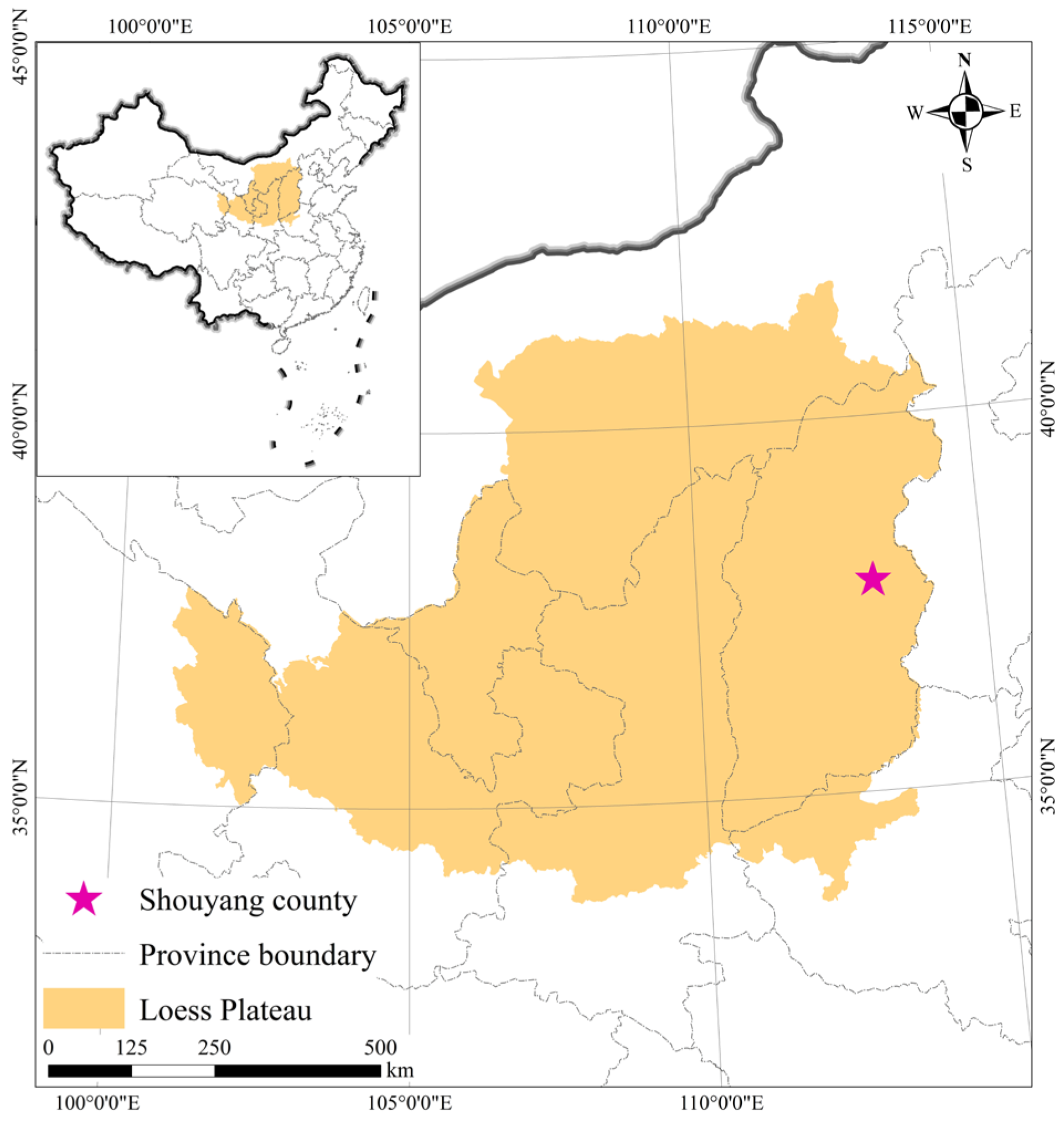
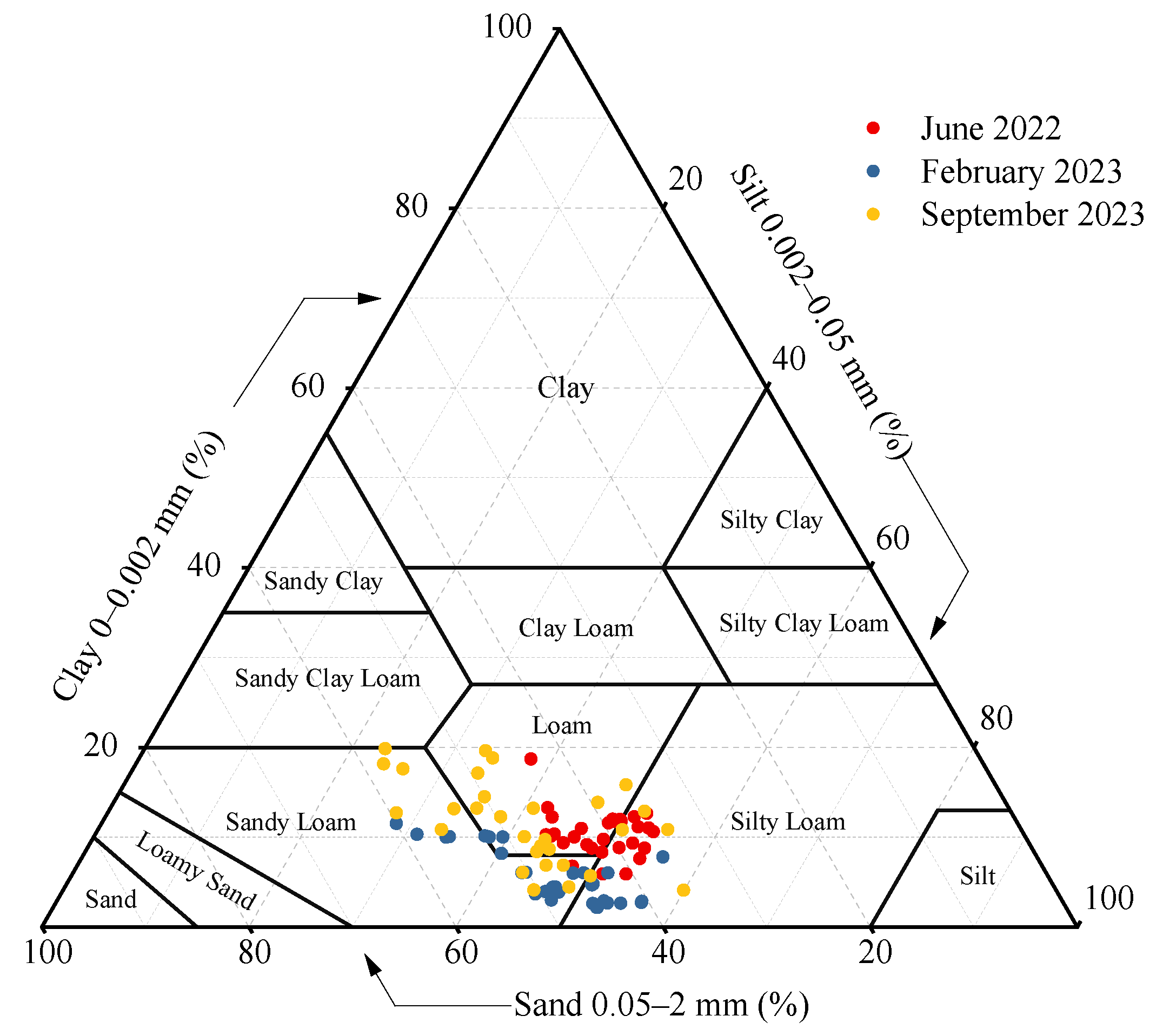
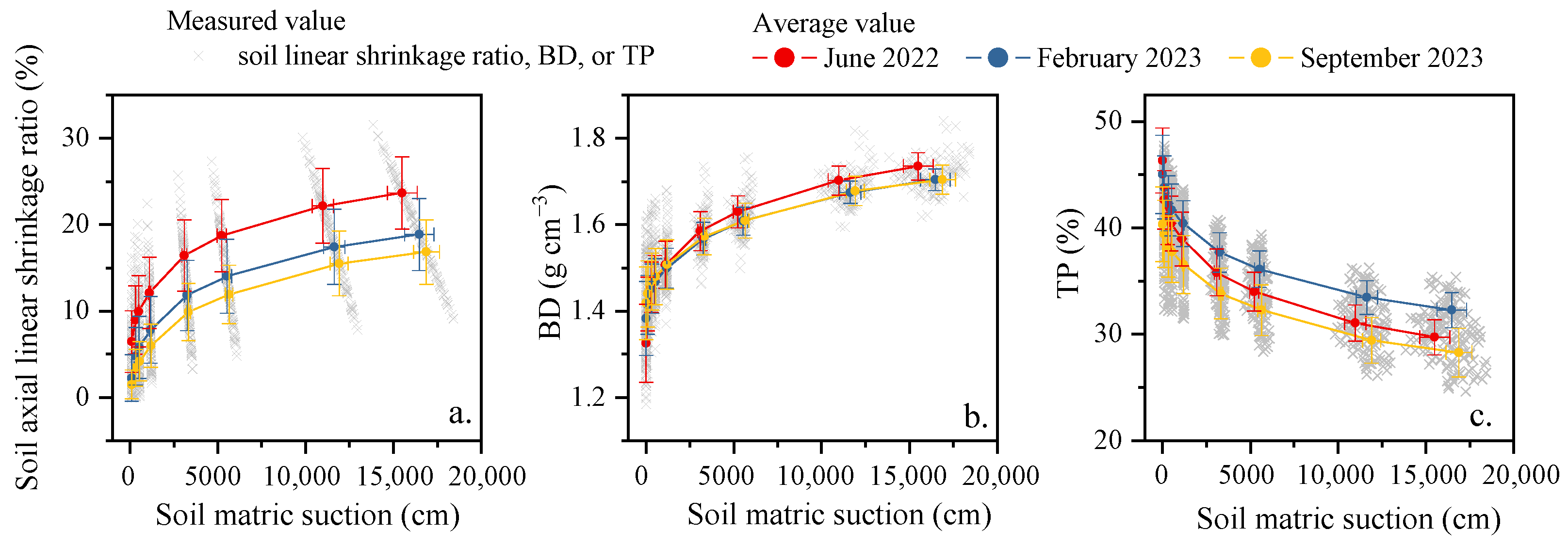


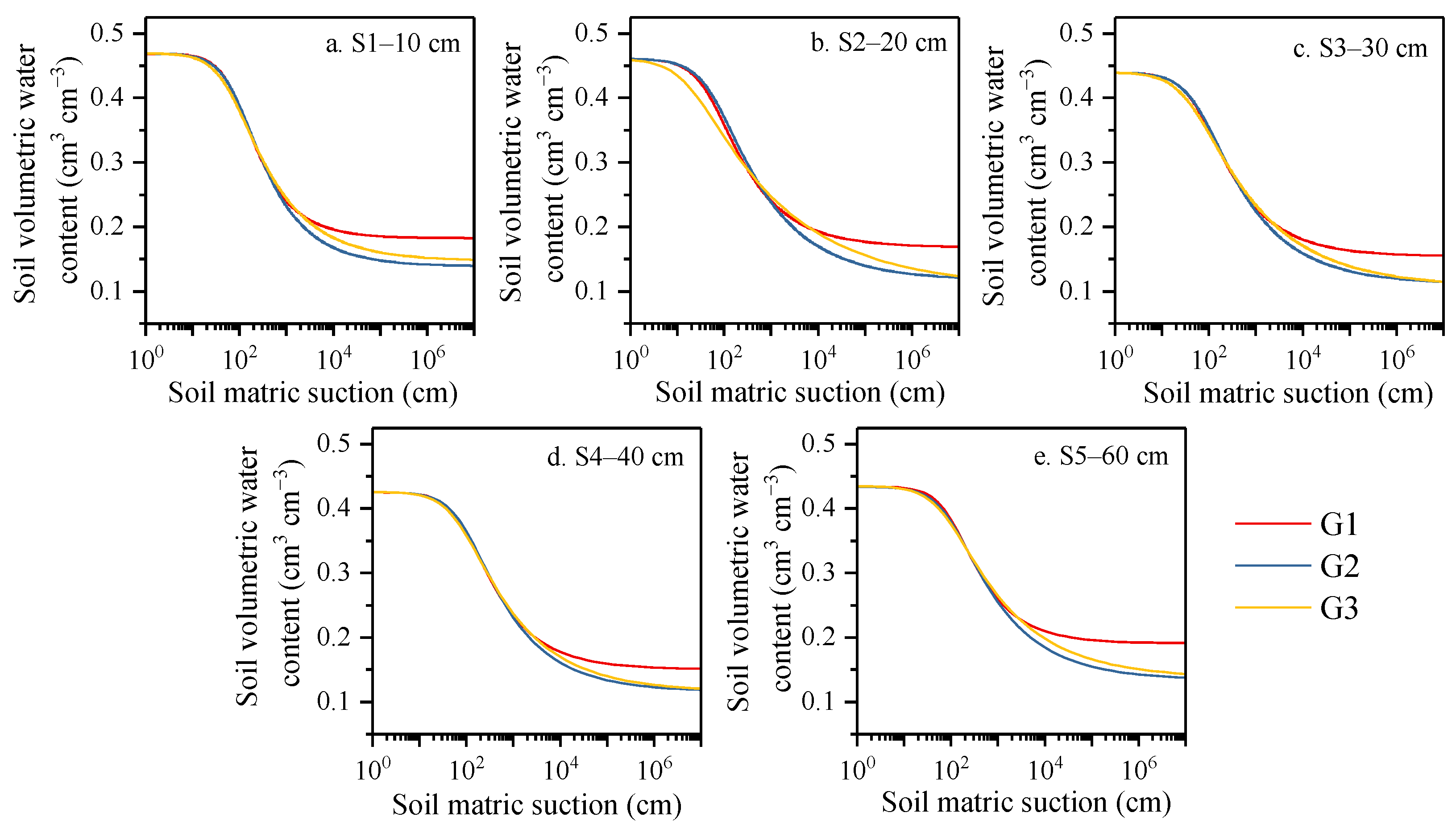
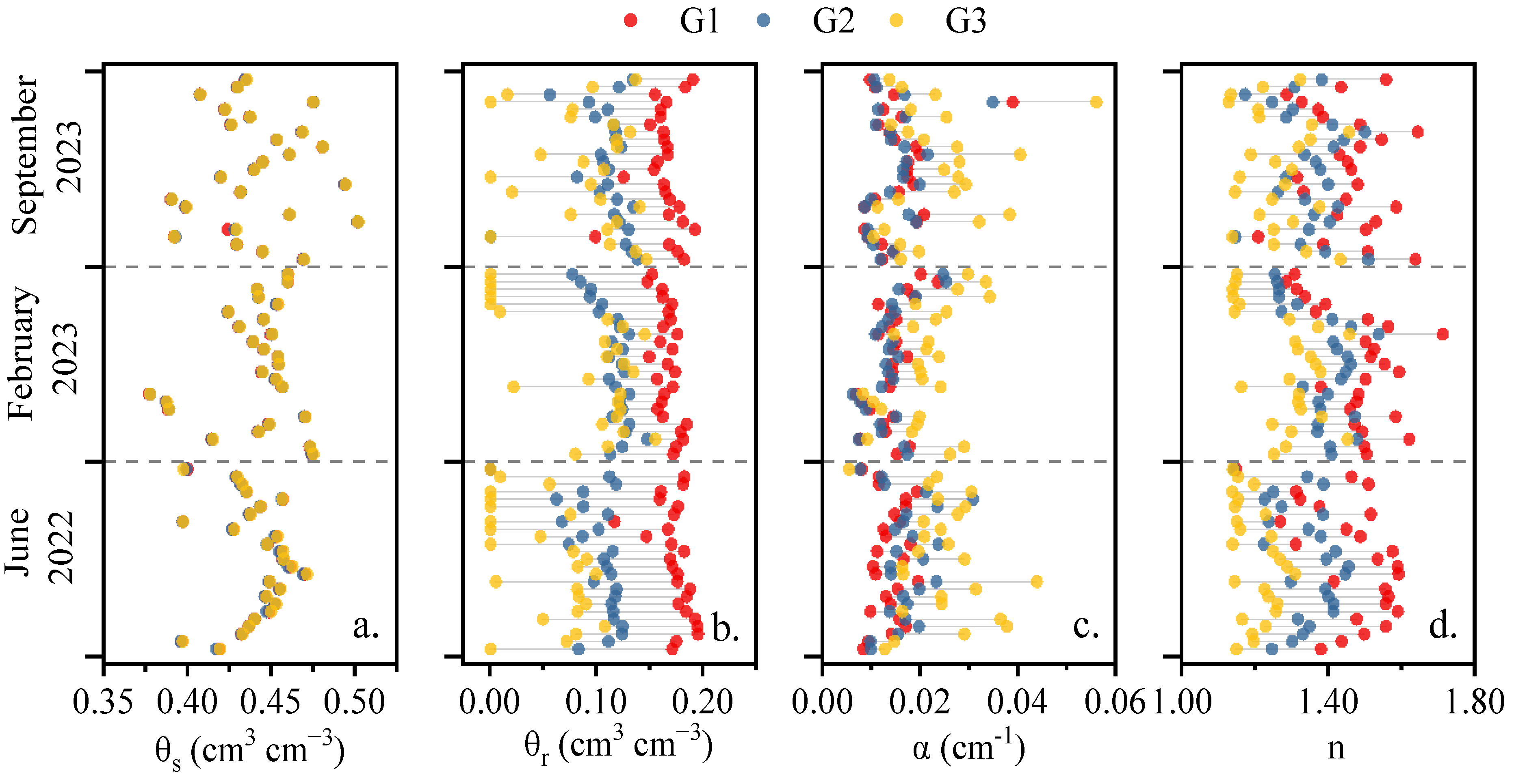


| Centrifugation Step (i) | 0 | 1 | 2 | 3 | 4 | 5 | 6 | 7 | 8 |
|---|---|---|---|---|---|---|---|---|---|
| Revolution speeds (rpm) | - | 700 | 1250 | 1600 | 2400 | 4100 | 5400 | 8000 | 9600 |
| Equilibrium time (min) | - | 40 | 40 | 45 | 45 | 45 | 60 | 60 | 75 |
| Methods | R2 | MAE (cm3 cm−3) | MAPE (%) | RMSE (cm3 cm−3) |
|---|---|---|---|---|
| Saturated volumetric water content (θs) | ||||
| G1 | 0.3111 | 0.0200 | 4.44 | 0.0257 |
| G2 | 0.3136 | 0.0197 | 4.38 | 0.0254 |
| G3 | 0.3201 | 0.0194 | 4.31 | 0.0251 |
| Field capacity (FC) | ||||
| G1 | 0.1769 | 0.0451 | 18.23 | 0.0491 |
| G2 | 0.0354 | 0.0397 | 16.20 | 0.0453 |
| G3 | 0.1858 | 0.0494 | 19.93 | 0.0529 |
| Permanent wilting point (PWP) | ||||
| G1 | 0.2626 | 0.0803 | 70.52 | 0.0811 |
| G2 | 0.1757 | 0.0482 | 42.37 | 0.0449 |
| G3 | 0.2341 | 0.0631 | 55.48 | 0.0641 |
| Methods | R2 | MAE (cm3 cm−3) | MAPE (%) | RMSE (cm3 cm−3) |
|---|---|---|---|---|
| 2022 | ||||
| G1 | 0.8629 | 0.0069 | 3.13 | 0.0091 |
| G2 | 0.8046 | 0.0086 | 3.91 | 0.0108 |
| G3 | 0.8793 | 0.0065 | 2.93 | 0.0085 |
| 2023 | ||||
| G1 | 0.7932 | 0.0085 | 4.59 | 0.0108 |
| G2 | 0.7905 | 0.0088 | 4.65 | 0.0108 |
| G3 | 0.7954 | 0.0085 | 4.55 | 0.0107 |
| Aggregated data | ||||
| G1 | 0.7932 | 0.0075 | 3.69 | 0.0098 |
| G2 | 0.8436 | 0.0087 | 4.19 | 0.0108 |
| G3 | 0.8819 | 0.0073 | 3.55 | 0.0094 |
Disclaimer/Publisher’s Note: The statements, opinions and data contained in all publications are solely those of the individual author(s) and contributor(s) and not of MDPI and/or the editor(s). MDPI and/or the editor(s) disclaim responsibility for any injury to people or property resulting from any ideas, methods, instructions or products referred to in the content. |
© 2025 by the authors. Licensee MDPI, Basel, Switzerland. This article is an open access article distributed under the terms and conditions of the Creative Commons Attribution (CC BY) license (https://creativecommons.org/licenses/by/4.0/).
Share and Cite
Li, B.; Pan, H.; Tian, Y.; Jiao, X. A Simple Method Using High Matric Suction Calibration Points to Optimize Soil–Water Characteristic Curves Derived from the Centrifuge Method. Agriculture 2025, 15, 2223. https://doi.org/10.3390/agriculture15212223
Li B, Pan H, Tian Y, Jiao X. A Simple Method Using High Matric Suction Calibration Points to Optimize Soil–Water Characteristic Curves Derived from the Centrifuge Method. Agriculture. 2025; 15(21):2223. https://doi.org/10.3390/agriculture15212223
Chicago/Turabian StyleLi, Bo, Hongyi Pan, Yue Tian, and Xiaoyan Jiao. 2025. "A Simple Method Using High Matric Suction Calibration Points to Optimize Soil–Water Characteristic Curves Derived from the Centrifuge Method" Agriculture 15, no. 21: 2223. https://doi.org/10.3390/agriculture15212223
APA StyleLi, B., Pan, H., Tian, Y., & Jiao, X. (2025). A Simple Method Using High Matric Suction Calibration Points to Optimize Soil–Water Characteristic Curves Derived from the Centrifuge Method. Agriculture, 15(21), 2223. https://doi.org/10.3390/agriculture15212223






